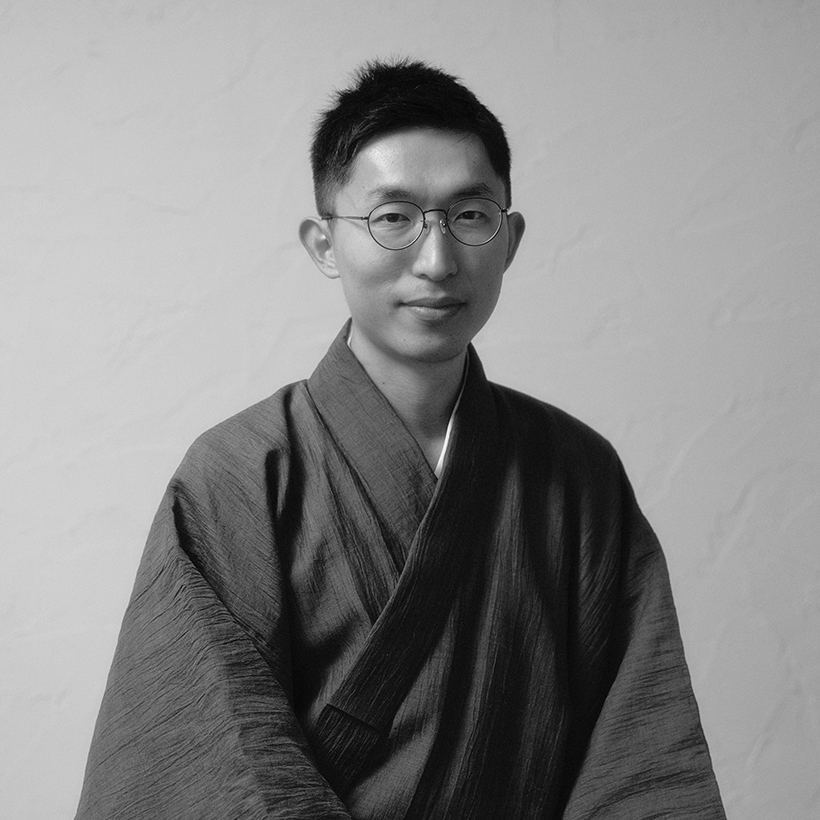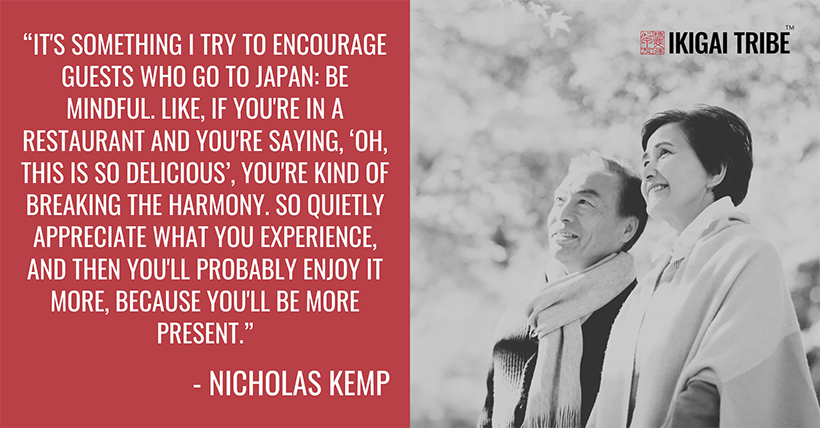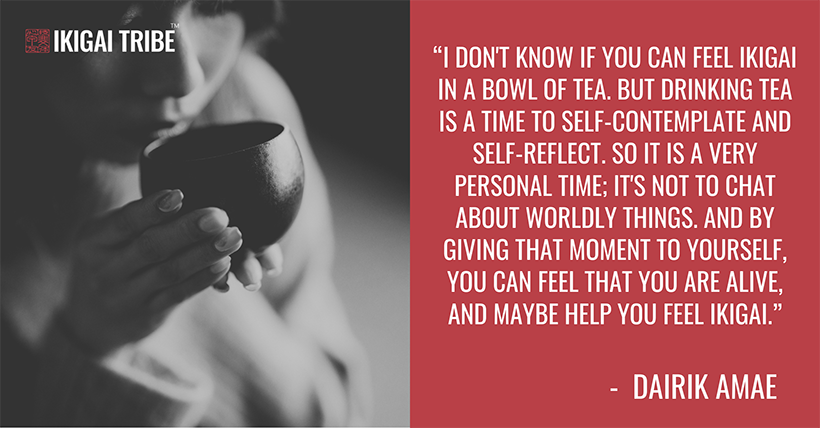What can a single sip of tea reveal?
In this episode of the Ikigai Podcast, Nick speaks with Dairik Amae on how the simple act of drinking tea can become a doorway to stillness.
Podcast Highlights
- Dairik’s backstory. Dairik shares a bit about his background.
- Being a tea practitioner. Dairik shares what led him to become one.
- The concept of serving tea. Dairik discusses the various interpretations of what it means to serve tea.
- Two types of gatherings. Dairik explains the two main types of tea gatherings.
- The practice of tea gathering. Dairik shares the process of tea gathering.
- Wa Kei Sei Jaku. Dairik talks about the four principles of tea.
- Impact of tea practice on everyday life. Dairik shares how practicing the Way of Tea can influence other aspects of life.
- Embracing silence in the tea practice. Dairik explains how tea ceremonies incorporate non-verbal communication.
- Rising interest in matcha. Dairik discusses the growing global demand for matcha.
- The emergence of matcha-style tea. Dairik shares how this style of tea came to be.
- Influence as a tea practitioner. Dairik shares how he influences others through his tea practice.
- Experiencing ikigai in a bowl of tea. Dairik shares whether it is possible to feel ikigai through a single cup of tea.
- ToTouSha. Dairik talks about his teahouse, ToTouSha.
Dairik Amae

Dairik Amae is a contemporary tea practitioner and teacher based in the ancient capital of Kyoto, the epicenter of tea culture in Japan. Dairik began his practice in Japanese Tea Ceremony at the age of 19, and has a background in Japanese architecture as well as in design. Over the years he has lived in multiple countries including Korea, Russia, the U.S., Syria and Ukraine, and now calls Kyoto home.
LINKS:
Totousha
Dairik’s backstory
Dairik was born to Japanese parents in Seoul, South Korea, and lived in several countries—including Russia, Hawaii, Syria, Ukraine, and now Japan—due to his father's work as a diplomat. While moving frequently was challenging, especially as a child constantly adjusting to new cultures and saying goodbye to friends, the experience ultimately taught him to appreciate diverse perspectives and ways of life.
Dairik returned to Japan around age 17, just before university. Curious about his heritage after years abroad, he became interested in traditional Japanese culture. Initially studying architecture—particularly traditional wooden structures—he was especially drawn to the tea room. This sparked a deeper interest in the Japanese tea ceremony.
Being a tea practitioner
Dairik’s interest in Japanese tea practice is deeply connected to architecture and design. The Japanese tea ceremony is holistic, encompassing various arts like flower arrangement, calligraphy, gardening, and cuisine, which appealed to him as a university student wanting a broad perspective rather than a narrow specialization. His tea master, Soren Bisgaard, is a Danish practitioner of the Urasenke school—one of the three main schools of Japanese tea ceremony.
The concept of serving tea
Dairik explains that the concept of serving tea has varied interpretations depending on the time period, but the core idea is captured by the term sado or chado—the ‘Way of Tea.’ Similar to other Japanese arts like shodo (calligraphy) and kado (flower arranging), it represents a way of life centered around a specific aesthetic. In his case, that aesthetic is about appreciating subtle and simple beauty.
While the term ‘tea ceremony’ was popularized by Okakura Kakuzo, a Japanese scholar and art critic, to describe Japanese culture to the West, Dairik prefers more flexible terms like ‘tea gathering’ or ‘tea ritual.’ Influenced by Zen philosophy, the Way of Tea has no strict right or wrong and adapts like water—shapeless yet profound, open to personal interpretation.
Two types of tea gatherings
Dairik describes two main types of tea gatherings in Japanese tea practice. The first is chakai, an informal tea gathering open to the public. It’s usually shorter, ranging from 30 to 90 minutes, and includes sweets (wagashi) and tea. The second is chaji, a formal, private event for invited guests only. Chaji can last three to four hours and includes a full-course meal (kaiseki), along with two types of tea—thick and thin. The main purpose of chaji is to create an intimate atmosphere between the host and guests.

The practice of tea gathering
In the tea gathering, the host serves while the guests receive, maintaining a passive role. The host does not eat or drink in the same space as the guests, instead eating separately in the back. This dynamic, known as the ‘Ying/Yang’ relationship, reflects a historical practice, particularly among samurai lords, where the host would show respect by serving without eating in front of a guest of higher status, such as a lord.
Wa Kei Sei Jaku
The practice of chanoyu (the Way of Tea) is guided by four core principles: Wa (harmony), Kei (respect), Sei (purity), and Jaku (tranquility).
Wa stems from Taoism and emphasizes harmony with both nature and one’s inner self.
Kei, rooted in Confucianism, focuses on respect—toward elders, objects, and wisdom in all forms.
Sei, derived from Shinto practices, involves cleanliness and purification of the mind and space.
Jaku, influenced by Buddhism, represents tranquility or awareness, which naturally arises when the other three principles are practiced.
These principles not only guide tea gatherings but also serve as values for living a mindful and respectful life.
Impact of tea practice on everyday life
Practicing the tea ceremony helps cultivate mindfulness and appreciation for everyday objects. Dairik shares a personal story about eating ice cream with a plastic spoon, which he handled with the same care as tea utensils. This made him notice the thoughtful design and quality of the spoon—something he had previously overlooked. Through tea practice, he learned to see beauty and wisdom in the small, often unnoticed details of daily life.
Embracing silence in the tea practice
Non-verbal communication in the tea ceremony is a shared, wordless experience—like feeling a summer breeze or sitting around a bonfire in silence with others. Though no words are exchanged, there's mutual understanding and connection. This silent communication, called kehai in Japanese, reflects the ability to ‘read the air’ and sense what others are feeling or thinking.

Rising interest in matcha
Dairik highlights the growing global demand for matcha, including high-quality varieties traditionally used in tea gatherings. While increased interest benefits tea farmers, he notes a widespread lack of understanding about how matcha should be enjoyed. Many consumers use premium matcha for lattes or sweetened drinks, masking its natural flavor and wasting its quality.
He emphasizes that different grades of matcha serve different purposes—some are for mixing, while others are best enjoyed straight. Additionally, there's a shortage of traditional tools like bamboo whisks, which are often misused. He suggests the need for better education and more accurate information beyond what is seen on social media.
The emergence of matcha-style tea
Tea is not native to Japan and was introduced alongside Buddhism, originating from China. The powdered tea method existed early on but evolved uniquely in Japan, particularly with the development of matcha. Japanese farmers began shading tea plants to increase chlorophyll and amino acids, creating the vibrant green color and enhancing umami flavor—hallmarks of high-quality matcha. This shading technique makes the leaves softer and better suited for fine powder.
Although modern tea grading emphasizes color, taste, and aroma, true health benefits—like increased L-theanine for calmness and EGCG antioxidants—depend on soil quality and freshness. Matcha's calming effects are why it was favored by Zen monks for meditation.
Influence as a tea practitioner
Dairik began practicing tea at 19 with the intention of spreading its philosophy, but over time, his focus shifted to simply living by example. Now 37, he values authenticity over preaching and believes in creating a peaceful space where visitors can feel safe, present, and content without expectations. He describes the atmosphere he offers as a state of ‘happy-boring,’ where simplicity and stillness are enough.
Experiencing ikigai in a bowl of tea
For Dairik, ikigai is not commonly used in everyday Japanese and lacks a fixed definition. To him, ikigai relates to feeling alive, which he connects with being present and self-aware. While he isn’t sure whether one can truly feel ikigai in a bowl of tea, he believes that setting aside expectations and simply being with oneself during tea can foster self-reflection and a sense of aliveness that may help one experience ikigai.
“I don't know if you can feel ikigai in a bowl of tea, but we, we say, you know, putting aside all expectations. And, you know, putting aside all desires and just kind of feeling yourself. You know, how do you feel? And it's, I think, time to self contemplate and self reflect. So it's kind of a very personal time. It's not to chat about worldly things. And I think giving that moment to yourself, one can feel that you are alive, and maybe helps you feel ikigai." - Dairik Amae

ToTouSha
ToTouSha is Dairik's teahouse, located on the grounds of the Zen Buddhist temple Daitokuji. Established in 2013, it serves as a space for teaching, personal practice, and welcoming those curious about tea. Dairik describes the tea room as an ibasho—a place of belonging—comparable to a childhood secret base where one can feel at home, be themselves, and connect to a small, personal world.Conclusion
Tea consumption has been growing in popularity around the world. While varieties like matcha can be enjoyed in creative blends and modern fusions, understanding the traditional methods of preparation and mindful consumption is key to unlocking their full health benefits. Often, simplicity is the key—savoring a bowl of tea in its purest form, and taking a moment for quiet reflection with each sip, may be all it takes to experience its remarkable effects.
